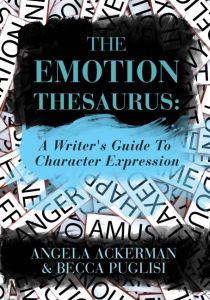I’ve mentioned before that I love subtext. I’ve analyzed the Spiderman reboot for subtext. I’ve written about how to revise for subtext, how to use subtext in emotional scenes, and how character development happens in subtext. Yeah, I’m a tad obsessed with subtext.
So when the fantastic Angela Ackerman of The Bookshelf Muse blog offered to do a guest post about using body language cues as subtext to show that a character is lying, you bet I jumped at the chance. *smile* Please welcome Angela Ackerman!
*****
Liar, Liar, Pants on Fire
People lie. They lie about the small things (that dress looks great on you!) and big things (I have no idea how that lipstick napkin got into my pocket, really!) And by natural extension, characters lie too.
Writing lies can be tricky if the liar isn’t the Point Of View Character. After all, thoughts and internal (visceral) sensations will tip us off when we’re in someone’s POV, but when we aren’t, it’s all up to body language and the reader’s honed sense of observation.
So, if writers need to ‘out’ a liar to the reader or have the POV character pick up on another’s lie, what’s the best way to go about it?
The Fake Smile. Natural, genuine smiles use a lot of muscles. Cheeks bunch up, brows comes down, eyes crinkle. When a character is faking it, the mouth stretches, and that’s it.
Reaction Time. When someone reacts based on emotion, gestures and movement are smooth and happen immediately. But if someone is not being genuine, a hiccup occurs in the timing. Imagine Aunt May asking you what you think of her new red hair color. The first thing that comes to mind is that she looks like someone auditioning for the role of Ronald McDonald, but will you say that? Of course not. So as you scramble for something nice to say, there’s a delay.
Personal Space. For most people, lying isn’t something they are proud of. It’s a normal reaction for someone to draw back, increase the space between themselves and others, or to place something between them as a shield or block. A lying person will have smaller movements which might appear wooden or have that time delay discussed earlier. Overall, their body tends to take up less space than someone at ease.
The Eyes Tell All. Because of the shame factor, often liars will not look you in the eye, or if they do, they cannot maintain contact for long. And that adage about looking up and to the left when you’re responding with a lie? It’s true! Looking up and to the right shows that the brain is accessing a remembered image, while looking up and to the left shows the brain is constructing an image. So, a person would look up and to the left while they are crafting a response rather than relaying natural truth.
Discomfort. Liars have one goal–for you to believe the lie and move on. They are not good at waiting, and if there are silences during conversation, they will often ramble to fill them or change the subject. They may fidget, and are likely to touch their face (ears, cheeks, mouth and nose). Some may prattle or give more detail than is needed, because their mission is to convince others to believe their words as truth. Often they will not answer questions directly, but talk ‘around’ an answer.
Micro expressions. The face can show a lot in a split second. Micro expressions are just that–true involuntary expressions made in that lightning quick moment before delivering a lie. These expressions are grouped into seven recognized emotions: sadness, happiness, fear, anger, disgust, contempt and surprise. The micro expression betrays what a person is really feeling, so if their next words or actions don’t match up, you’ve just caught them in a lie.
Denial. When a normal person is accused of lying, confusion is often the response, paired with a request for clarification. When a liar is outed, they react quickly and with passion, rejecting the statement and claiming complete denial.
Voice. Speech patterns often shift when a person is lying. Rushed speech, not pausing for breath, drawing out one’s words, the voice growing higher or lower than usual, a warble entering one’s voice…these can all be signs of discomfort with what one is saying. If something doesn’t sound right, there’s usually a reason for it.
Are there liars who don’t follow these rules? Certainly! The best liars are ones that know exactly how the body reacts when a lie is told, and through practice, have mastered many of the universal ‘tells’ that go with lying. But for the majority who aren’t majoring in deceit, these constants hold true. Decide if your character is a natural born liar or not and you’ll have a starting point as to what to show to denote a lie!
*****
 Angela Ackerman is one half of The Bookshelf Muse blogging duo, and co-author of The Emotion Thesaurus: A Writer’s Guide to Character Expression. Listing the body language, visceral reactions and thoughts associated with seventy-fivedifferent emotions, this brainstorming guide is a valuable tool for showing, not telling, emotion. She lives in Calgary, Alberta, in the shadow of the Rockies, with her crazy (and therefore awesome) family, dog and one slightly zombie-like fish.
Angela Ackerman is one half of The Bookshelf Muse blogging duo, and co-author of The Emotion Thesaurus: A Writer’s Guide to Character Expression. Listing the body language, visceral reactions and thoughts associated with seventy-fivedifferent emotions, this brainstorming guide is a valuable tool for showing, not telling, emotion. She lives in Calgary, Alberta, in the shadow of the Rockies, with her crazy (and therefore awesome) family, dog and one slightly zombie-like fish.
*****
Subtext is cool, isn’t it? Angela and Becca’s book is phenomenal for learning all these body language cues. No more telling or naming emotions. Show them instead.
And as a pantser (someone who writes by the seat of her pants), I’m curious if I’m the only one who’s written a liar but didn’t realize it right away. *smile* What finally gave it away to you? Did your other characters realize it before you did? *raises hand* (These are just some of the reasons I find liars a blast to write.)
And Angela wants to know:
How about you…have you ever written a liar into your stories? Are they fun to write? How did you go about conveying this to the reader? Let me know in the comments!

